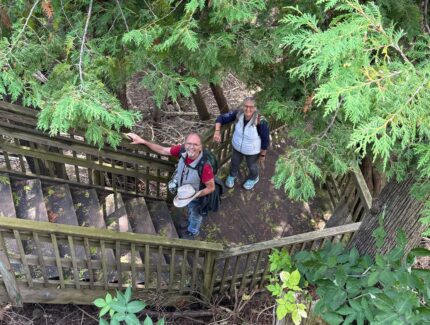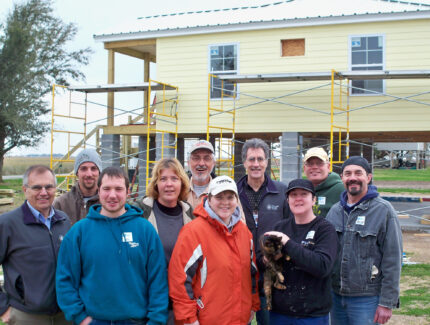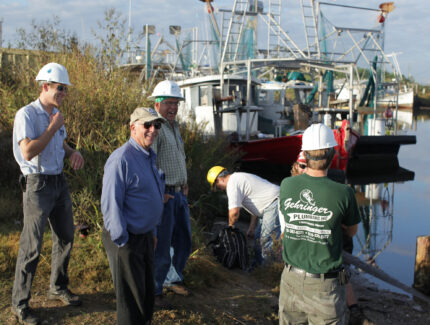
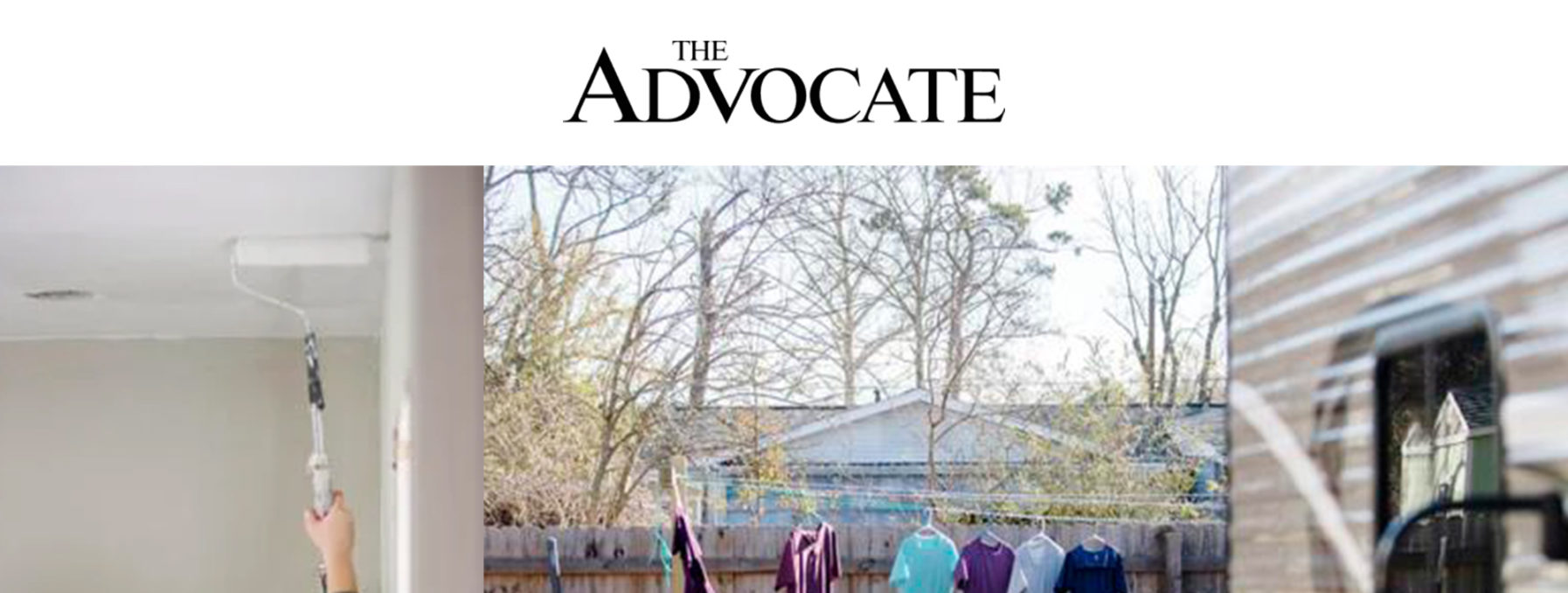
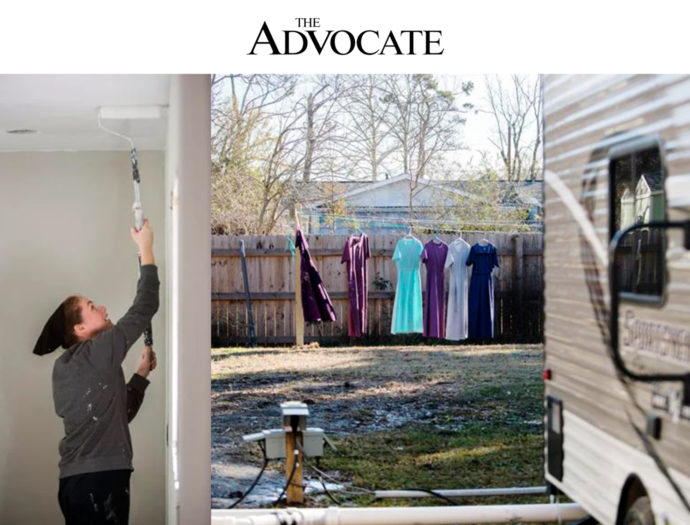
February 18, 2022
IN THE PRESS: ‘A calling’: Volunteers help Lake Charles’ slow rebuild
WESTLAKE — A language not usually heard in southwest Louisiana resounds through the unfinished walls of a hurricane-damaged house. A group of Amish volunteers, speaking Pennsylvania Dutch, hammer away at rebuilding it in this small city near Lake Charles.
“I’m a mason, personally,” said Marlin Schlabach, 28, of Millersburg, Ohio, as he worked on an interior wall in the house. “This is a little bit different story than what I’m used to.”
He and his fellow workers are among volunteers still arriving in this region nearly a year and a half after Hurricane Laura for a recovery effort badly hampered by the pandemic and a lack of federal aid. Such altruistic efforts have followed every storm that has done significant damage to south Louisiana in the past two decades.
But local officials say the volunteer army has been especially vital here, where the devastation wrought by Laura, one of the most powerful storms to ever make landfall in Louisiana, quickly fell off the nation’s radar. A combination of pandemic-induced restrictions and a lack of awareness of the struggles in the region, which also endured three other weather disasters in Laura’s wake, heightened the need for help.
Gid Yoder, of Mennonite Disaster Service and Disaster Aid Ohio, has been helping coordinate groups of Amish volunteers in the Lake Charles area in recent weeks. He said he was surprised to see how much damage remains 18 months later.
“We really were,” he said in a makeshift office at a Methodist church in Lake Charles where the group has been coordinating its activity, work plans pinned to the wall behind him. “I’m surprised some people that we’ve come and talked to have said they have the third tarp on and that tarp has shattered. And so, you wonder — I don’t know why they couldn’t get help.”
Bill Howell, head of outreach for the United Methodist Church’s Louisiana Conference, which has formed a coalition that included Yoder’s charity and helped organize its mission, said his organization was among those that struggled to send volunteers for months after the start of the pandemic.
He was grateful that the Amish volunteers were available to arrive in January and said they carry out their assigned tasks like clockwork. The Amish more broadly are known for their community projects such as barn raisings.

Gid Yoder, with Mennonite Disaster Service, talks about the work he and other Amish volunteers are undertaking Wednesday, January 26, 2022, in Lake Charles, La.
STAFF PHOTO BY LESLIE WESTBROOK
“It’s amazing,” Howell said, describing one of the houses they repaired. “They stripped it, they repaired it structurally and they put the roof on all in one day.”
For David Hall, whose Westlake home was being repaired by the volunteers, the help is a godsend. A tree fell through his house, and a contractor he hired to fix it didn’t do the job. The 75-year-old and his wife, both of whom are hearing-impaired, have been living in a FEMA mobile home next door.
* * *
Lack of attention
Despite the months that have passed, hurricane damage is ubiquitous around Lake Charles. There has certainly been progress, but blue tarps are still a fixture of the landscape. Nearly 2,000 families remain in FEMA temporary housing, mainly travel trailers and mobile homes.
Homeowners who had insurance have often found themselves in an all-out battle — sometimes through lawsuits — to claw back the amount they say is needed to rebuild. Those without insurance and renters who were in public and affordable housing have been hit especially hard.
Long-term federal relief was finally approved by Congress in late September. But the $600 million appropriated, much of which will go toward housing, is not expected to reach the region until around May. Homeowners who may qualify are being encouraged to complete a survey at restore.la.gov.
In pushing Washington to provide further relief, Gov. John Bel Edwards has spoken of around $1 billion in still-unmet housing needs from Laura, Hurricane Delta, which followed a similar path about six weeks later, and Hurricane Zeta, which hit southeast Louisiana in October 2020.
The vast majority of those needs are in southwest Louisiana, which in addition to Laura and Delta also saw a severe winter storm in February 2021 and heavy flooding in May. Many have sought help through their churches, the United Way or the Red Cross, but the pandemic restricted volunteers.
Kevin Watterson of ReachGlobal Crisis Response, part of the Evangelical Free Church denomination, said his organization was largely unable to deploy volunteers until about three months into the pandemic, and then in far fewer numbers than would have usually been deployed.
In normal times, the organization would be able to handle between 25 and 40 volunteers per week, he said. That had to be reduced to 10 to 15, and sometimes less, in the months after the shutdown began since only one group could be accepted at a time. Restrictions have more recently been eased.
He said the region’s lack of visibility also played a role in limiting help and donations. Without the cachet of New Orleans or the population and corporate base of Houston, the Lake Charles area and its struggles were never in the national consciousness or on its TV screens the way other storm recoveries have been.
Donations to his organization for Hurricane Harvey, the powerful 2017 storm that hit Texas, reached nearly $1 million, said Watterson. For Laura, they’ve been short of $100,000.

Andrew Schlabach, right, and Maynard Yoder repair the roof of a resident whose home was damaged by Hurricane Laura Wednesday, January 26, 2022, in Westlake, La.
STAFF PHOTO BY LESLIE WESTBROOK
A similar outcome has played out for Hurricane Ida, a Category 4 storm whose biggest impact was felt in smaller communities outside New Orleans. Donations have been in the range of $75,000, he said.
“I think part of the problem was that (Ida) impacted the coast and didn’t impact New Orleans in the same way that Katrina did obviously,” said Watterson. “But it was still Katrina-like for Hammond and LaPlace and places south.”
By other measurements, Ida survivors have fared better than communities in Laura’s path. The most blatant example involves federal disaster relief. Some of the money intended to address long-term rebuilding needs related to Ida was approved by Congress at the same time it approved Laura relief — even though Laura hit a year earlier.
* * *
‘If you have the means’
The United Way of Southwest Louisiana has been key in coordinating volunteer efforts following Laura and Delta. Denise Durel, who heads the organization, said the pandemic slowed the response.
“Initially, it made it difficult for organizations to get any volunteers from outside the region,” she said by email. “However, many of them acquired assistance from local community members, all while taking the necessary precautions due to the pandemic.”
She added: “Currently, the organizations have been able to bring in their own groups of volunteers from outside of the area. They still maintain the necessary safety precautions.”
The United Way partnered with Catholic Charities and the Community Foundation of Southwest Louisiana to provide funding for various groups carrying out long-term repair work, said Durel. More than 100 homes have been worked on through those efforts, she said.
The American Red Cross was instrumental in providing shelter and supplies after Laura and Delta with more than 2,000 workers involved, though the number of in-person responders was reduced, while “virtual volunteers” called survivors to discuss their needs. The group says it provided over 670,000 overnight stays related to those storms.

Leah Yoder helps paint a resident’s home that was damaged by Hurricane Laura Wednesday, January 26, 2022, in Lake Charles, La.
STAFF PHOTO BY LESLIE WESTBROOK
“In 2020, the earliest months of the pandemic and before vaccines were available, we utilized a variety of resources to meet the needs of residents affected by hurricanes Laura and Delta,” it said. “Last year after Hurricane Ida, when vaccines were widely available, we returned to in-person services, including congregate sheltering, where appropriate.”
Other groups that have provided substantial help in the Lake Charles area include the Samaritan’s Purse charity.
“The help that we got following the disasters was tremendous,” said Brian Abshire, a Calcasieu Parish police juror who was until recently the body’s president. “I don’t know that the recovery would have kicked off quite as fast as it did without help from those people.”
Yoder’s group was a model of efficiency. To set up their base, they had enclosed a canopy behind the church with temporary walls and connected it to a mobile kitchen, where two women were at work.
Twenty-nine jobs had been assigned through case workers, much of it involving roofing. They had finished about half since arriving last month. The winter is a good time for the group to volunteer in the country’s south because the cold back home limits activity.
“It’s basically a calling from God to help people,” Yoder said. “If you have the means to help somebody, I think it’s a calling that we feel we should do.”
This is a donation module.
Donate today!
